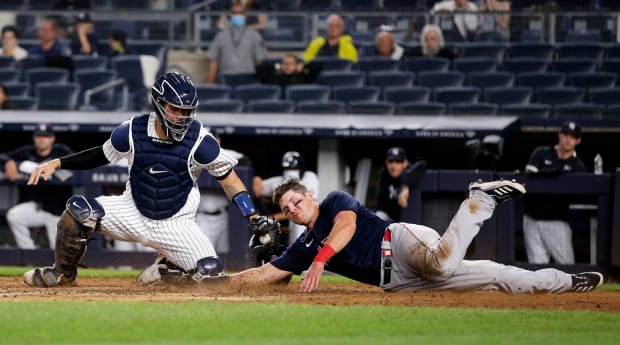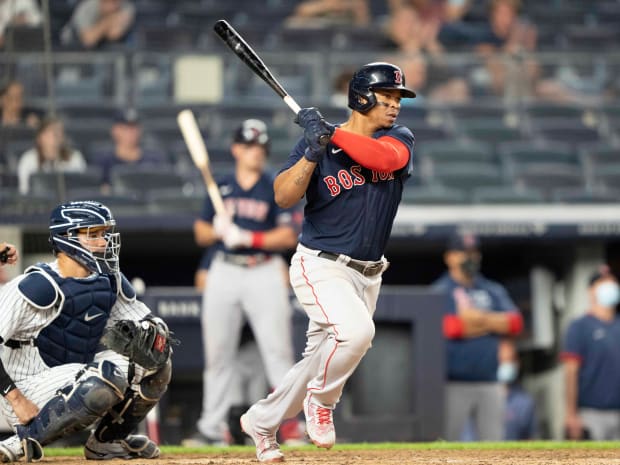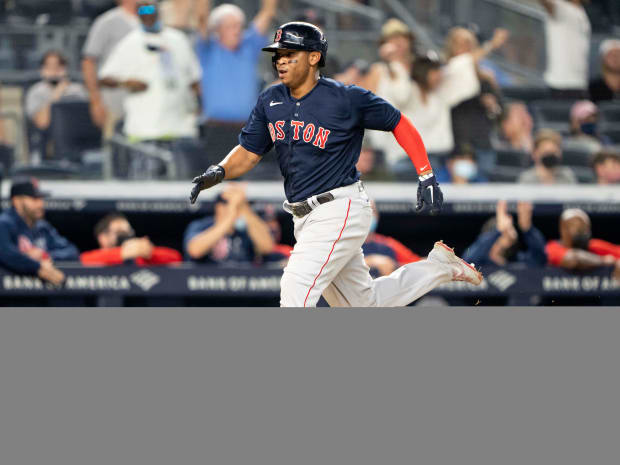Watching the Red Sox sweep the Yankees at Yankee Stadium for the first time in a decade was to see a contrast in styles
Welcome to The Opener, where every weekday morning you’ll get a fresh, topical column to start your day from one of SI.com’s MLB writers.
NEW YORK — Not since 1996 did baseball schedule the first meeting between the Yankees and Red Sox this deep into the season. With more than one-third of the season behind them, the truths that emerged from the weekend series at Yankee Stadium carried the weight of a large sample size. And no truth stood out more than this: New York is playing an outmoded style of baseball while Boston is a more functionable, aggressive team in a game that changes rapidly.
Watching the Red Sox sweep the Yankees at Yankee Stadium for the first time in a decade was to see a jarring contrast in styles. New York is still trying to win the way teams did in 2019, when a livelier ball with less drag produced a record rate of home runs. Boston has more adept hitters when it comes to capitalizing on a deader ball and on holes left open by shifting defenses, as well as using the basepaths to enhance run scoring opportunities.

“The ball is not carrying,” Boston manager Alex Cora says. “It’s like back in the day now, where as a hitter instead of trying to catch the fastball out front now you back track it—let it get deep—because the holes are on the other side of the field. Look at it this way: our best hitter, J.D. [Martinez], is not a home run hitter. He hits home runs, but he’s just a good hitter.”
The Yankees are stuck with the franchise’s worst hitting team since the DH was added in 1973. Baseball turned against their style in two major ways. First, teams have copied the style of how Tampa Bay has owned them: limiting their home runs by throwing them a ton of spin. Second, the deader baseball is turning 2019 home runs into 2021 outs.
There will be times, especially against home run-prone teams such as the Orioles, Twins and Angels, that New York will crush opponents with its power and hope will shine. But it can’t happen like it did in 2019. The Yankees have real systemic problems: they have no left-handed hitting, they are a terrible baserunning team and they don’t beat shifts or spin. Moreover, several hitters in their prime have regressed: Gleyber Torres, 24, Clint Frazier, 26, Gary Sánchez, 28, and Gio Urshela, 29.
Consider this a version of those “compare and contrast” essay questions from high school. Here are the major differences between the Yankees and Red Sox—not just seen over the weekend, but also as we reach 40% of the season this week. (All statistics as of entering play Sunday.)

1. The Baseball
This is not a good year to rely on home runs. Don’t be mistaken: home runs are great. They change games in an instant. Nothing promotes victory more than out-homering the opponent. But because MLB introduced a less lively baseball, you better diversify. The ball seems to be behaving exactly as MLB intended: it comes off the bat just as hard, but it doesn’t fly as far.
Opposite-field homers are down 26% from two years ago.
Opposite Field Home Runs Per Game
Bottom of the order hitters are not hitting cheap home runs—or much of anything:
Batting Order Hitters 7-9, Non-Pitchers
*Worst ever
The average exit velocity of a home run last year and in 2019 was 103.6. This year it is 104.8. It takes a little more to hit it out.
Take a fly ball hit between 103 and 104 mph—the average home run velocity in 2019. Struck the same way, the same flyball is far less likely to be a homer this year than it was in 2019:
Flyballs Hit 103-104 MPH
When you apply the same exercise specifically to the Yankees’ hitters, the effect is even more pronounced:
Flyballs Hit 103-104 MPH
2. The Tampa Bay Blueprint
The Rays have a pitching philosophy that you could simplify to this: show fastballs, put hitters away with spin. It works particularly well against the Yankees.
First, understand how important it has been for the Yankees to hit home runs off fastballs (this and all subsequent fastball references do not include cutters):
Most Home Runs Off Fastballs, 2018-20
Over the previous three seasons, the Yankees hit 19% more home runs off fastballs than any other American League team. That is staggering. So, what do you do if you’re the Rays? You throw them fewer fastballs:
Rays Pitchers vs. Yankees Hitters by Pitch Type, 2020-21
Secondary Pitches Behind Count, 2020-21
Secondary is primary. Guess what? It works. The Rays are 16-7 against the Yankees in that span. This year they have thrown the Yankees only 37.5% fastballs! The rest of baseball has noticed:
Fastballs Seen by Hitters, 2021
The game changed quickly. In the past four years fastball percentage dropped from 55% to 50%. You better be able to hit spin in today’s game. Advantage, Red Sox.
Batting vs. Secondary Pitches, 2021
3. Shifts
Shifts have essentially doubled since 2018, from 17.7% of all pitches to 34.6% this year. As Cora notes, that also means open areas of the field also have doubled.
As shifts increase and the ball is deader, it becomes more important to find those open areas. Advantage, Red Sox.
Opposite Field Hits vs. Shifts
4. Baserunning as an Offensive Tool
On Saturday the Red Sox and Yankees were tied in the bottom of the seventh inning. You got the feeling the team that scored next would win. When Gary Sánchez reached first on a one-out single, Yankees manager Aaron Boone inserted Tyler Wade to pinch run. Wade has a career stolen base success rate of 79%. The Boston pitcher, Garrett Whitlock, has a high leg kick, which slows his delivery to the plate.
There is no reason to pinch run Wade at first unless he’s going to run, which he should. (Most managers, with short benches these days, will wait until a runner gets to second to make such a speed upgrade if no stolen base is in order.)
Wade didn’t run. He was erased when Clint Frazier grounded into a double play.

In the very next inning, Rafael Devers (career stolen base success rate: 56%) was on first with Kiké Hernández at the plate. Hernandez had not had a hit in more than a week and had two strikes against Chad Green. Cora started Devers at first, which allowed him to score on a double to leftfield.
The Red Sox made something happen. The Yankees didn’t. That’s just one example that leads to this:
Run Scoring Percentage When Reaching Base
And this:
5. Big, Hairy Monsters
Back in the 2012 ALCS, when the Yankees hit .157 and scored six runs while getting swept by Detroit, Yankees GM Brian Cashman stood by his philosophy of packing the lineup with guys who hit home runs and took walks, especially if they were left-handed.
“We are still executing the Gene Michael playbook,” he said, “which is predominantly left-handed hitters that take walks. They are selective. They’re typically big, hairy monsters, as I describe them, that hit the ball over the fence, hit doubles, singles, can hit home runs.”
Where have all the monsters gone?
Yankees Lefty Hitters, 2021
New York played an entire series against Boston at Yankee Stadium while getting one hit (an infield single) by a left-handed hitter.
Giancarlo Stanton, D.J. LeMahieu and Aaron Judge are good hitters you want regardless of how your lineup is balanced. But Stanton (-.134), LeMahieu (-.089) and Judge (-.056) all have a significantly lower career OPS against right-handed pitchers. The Yankees need a quality left-handed bat.

Moreover, the big, hairy monsters Cashman does have from the right side often are not in the lineup. Between injuries and “load management,” Stanton and Judge have been in the same lineup only 25% of the time since 2019 (70 of 282. New York is 37-33 in those games.)
Stanton has played eight consecutive games only once in the past three seasons. That happened in April this year. He hit .444 with the regular work.
More MLB Coverage:
• 'This Should Be the Biggest Scandal in Sports'
• The Year of the Pitcher (Again)
• The Devastating Gig Economy of Relief Pitching
• The Five Best Trade Fits for Max Scherzer

0 Comments:
Post a Comment